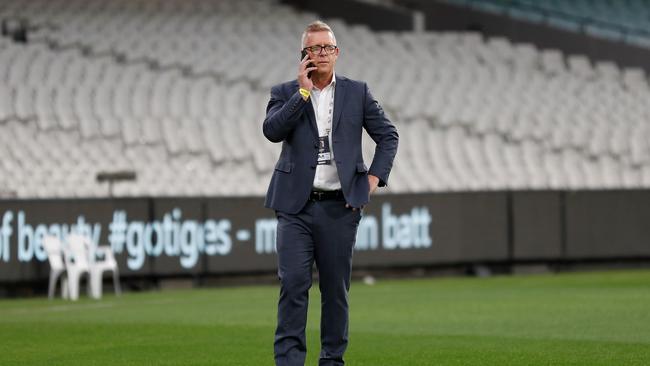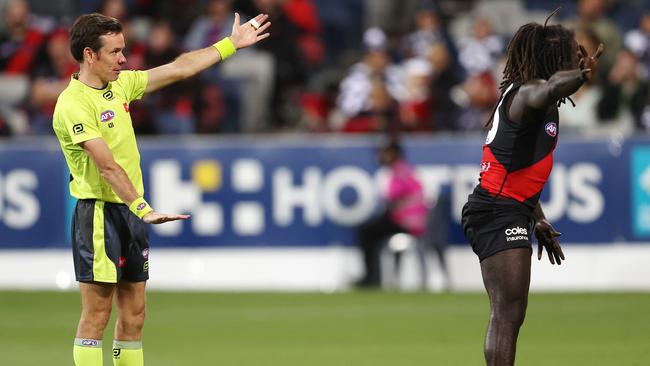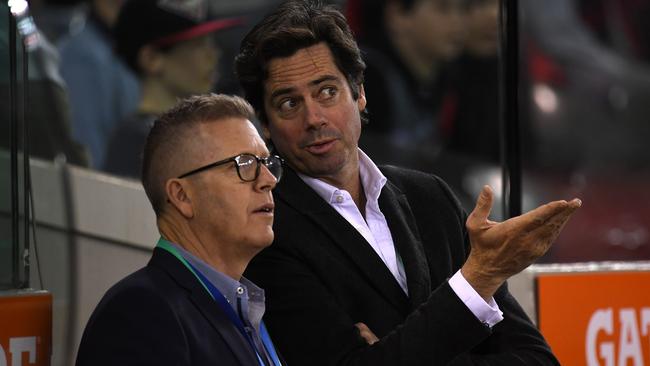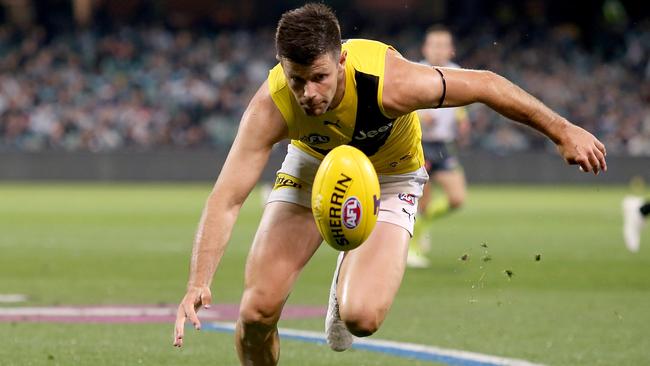AFL rules 2021: Did AFL footy boss Steve Hocking order man-on-the-mark rule change?
It is being championed as the new rule that will reshape the game of footy. So why won’t the AFL give a straight answer on whose idea it was?

AFL
Don't miss out on the headlines from AFL. Followed categories will be added to My News.
The bunker was designed specifically for this reason, along the same lines as the White House.
Only the most important people in the organisation were present given many were even unaware of the bunker’s existence.
The door was sealed tight, no-one else could gain access given the password was only known to the six people around the table.
Gillon McLachlan is looking at the folder in front of him which is marked: “Open Only in Emergency.”
The reason the AFL’s top brass have been called into the bunker was the state of the game, it was in crisis and something dramatic had to be done.
All of the commentary was about the ugliness of football, the lack of scoring, the congestion.
“It’s time,” a voice from the shadows to the left of McLachlan says. “We’re now code red. Repeat we are now code red.”
Watch every match of the 2021 AAMI Community Series LIVE on Kayo. New to Kayo? Try 14-Days Free Now >

WHO ORDERED MAN-ON-MARK RULE?
STEVE Hocking doesn’t give a straight answer.
He’s quite well versed at delivering a more than suitable response to the question, which he’s been asked numerous times over the past couple of weeks, but in the end avoids the real answer.
All that is clear is that the “code red” originated from his football operations department.
The code red is the new “stand” rule for the man-on-the-mark which some say has the potential to dramatically change the game.
Players are no longer allowed to deviate from their position on the mark or risk giving away a 50m penalty.
This allows the player with the ball to almost do as they please without any chance of a defender causing them any angst.
Hocking’s answer to how it came about, where it’s from or who is responsible for the rule adjustment is usually met with a “group decision” line.
This mystery group, or committee as there are plenty of those inside the league’s Docklands headquarters, apparently sits around on their laptops all day digesting data and throwing up ideas.
At some stage in the middle of last year one of the boffins came up with the rule some have likened to netball where standing, and not moving, is a feature.
It came into vogue in November when a number of rule changes were announced but much of the focus that day was on the reduction of interchange from 90 to 75.

The standing-still-on-the-mark line was slipped in there with the players told they were only to be allowed “minimal” lateral movement.
Not much was initially thought about it but word started to leak out as pre-season training kicked into gear in January that this was the rule that could change everything.
It burst into the psyche of footy fans after a couple of clips of infringements of the new rule from practice matches went viral online.
The outrage was instant. Most were up in arms, the league held its ground and waited anxiously to see how the “stand” rule got through last weekend’s pre-season competition.
On the opening night of the AAMI Community Series, Hocking would have been doing cartwheels on his couch given the breakneck speed with which St Kilda and Carlton went at it.
The champagne would have been popping 24 hours later when Richmond and Collingwood put on another eye-opening show full of speed and lots of scoring.
There were also no horror 50m penalties with both coaches agreeing the new rule had made a significant impact.
By the end of the nine matches over five days there was a consensus that Hocking and his nameless boffins might be on to something although not everyone was in favour.
Former Hawthorn and Carlton star Daniel Harford, who coaches the Blues’ AFLW team, likened the rule adjustment to the gimmicks which were used in the ill-fated AFLX.
“I think this new mark-stand situation will possibly be the most transformational decision the game has made in decades,” Harford said.
“When you mark the ball it is basically AFLX, it’s just open season, free flowing, no pressure, do what you like.
“That has never been the premise of the game, it has always been about finding a way through rather than being allowed to pass through at the mercy of the game.
“I just think it is going to have a dramatic impact on the game.
“The design of what they have done and what they wanted to create, I think from a small sample size is exactly what they were after.
“Philosophically I don’t think it should be that easy to get the ball from back to front, it shouldn’t be that easy to move the ball.”
WHAT’S THE BEST WAY TO SILENCE ANY DETRACTORS?
THE theory is that the best jokes always have a hint of truth in them.
AFL boss Gillon McLachlan was in a playful mood. Finally the season that so many times he thought wouldn’t happen was about to come to its crescendo with Richmond and Geelong squaring off in the 2020 Grand Final.
He was being quizzed on Fox Footy’s AFL 360 about possible changes to the game moving forward on the back of the successful shortened quarters during the COVID-19 season.
“We will do what we always do,” he said with a smile. “We’ll listen to everyone and then we’ll make our own decisions.”
Listening and engaging is what the AFL is very good at, if you need an ego stroked, a tummy rubbed then they can more than accommodate.
The AFL are geniuses at making people feel like they’re important and having a say in the running of the game when the reality is quite different.
What’s the best way to silence any detractors? You bring them into the fold and make them feel loved.

The Competition Committee is a brilliant example of this.
Created in 2018, it was established to “guide discussion” around decision-making for the AFL Commission and the league’s executive on key aspects of the future direction of the competition.
Some of the biggest names in town were invited to participate including Collingwood president Eddie McGuire, Richmond president Peggy O’Neal and Geelong president Colin Carter as well as CEOs Andrew Ireland and Justin Reeves.
Then North Melbourne coach Brad Scott and his Brisbane Lions counterpart Chris Fagan got a gig as did players Patrick Dangerfield and Steven May.
In the end it swelled to 17 individuals who it was sold to had effectively the keys to the game.
The reality of the situation soon dawned on many of the committee members that everything wasn’t all that it seemed.
They were clearly serving a purpose for the AFL, providing coverage in a way if something went wrong — ie the man-on-the-mark rule — as it had been through the Competition Committee.

“What you think it is and what it is are two different things,” one close observer said. “It’s basically designed to muzzle anyone who is outspoken.”
Several committee members were said to be amused by the recent interchange reduction which was presented to them by Hocking in the morning and announced officially at a press conference at 3pm.
That’s a short consultation period although their feedback on a free kick getting paid against defenders if they deliberately spoiled the ball out of bounds was taken on board with the rule change ditched.
It was a small win, and an important one for their feelings, but getting a couple of hours heads up on what the AFL is announcing isn’t what most envisaged when they took on the committee role.
So did the Competition Committee call code red?
That is a categoric no but another committee would certainly have more fingerprints over it.
The “Game Analysis Committee” is another Hocking baby and there are a number of his lieutenants who could be the mystery figure in the shadows.

Rob Auld, a former CEO of AFL Tasmania, is Hocking’s right-hand man while Scott joined the AFL last year as its competitions evolution manager although that title changed during the coronavirus pandemic.
One of the more influential people behind the scenes in Hocking’s team was Patrick Clifton, the AFL’s head of safety and laws, who was a wizard with data.
He was poached to the NBA in November so maybe the “stand” rule was his parting gift.
Or is it Hocking himself? Word has it he studied Richmond closely while in the hub in Queensland and grew increasingly angry at how the Tigers pushed the envelope when they stood the mark.
Captain Trent Cotchin is said to have been the No. 1 culprit, or expert depending on which way you look at, when it came to shutting down the corridor by encroaching on the mark.
Whatever happens in the ensuing weeks with the rule either firing or crashing spectacularly, the identity of the man who called code red may never be revealed.
And that’s exactly how the AFL wants it.






